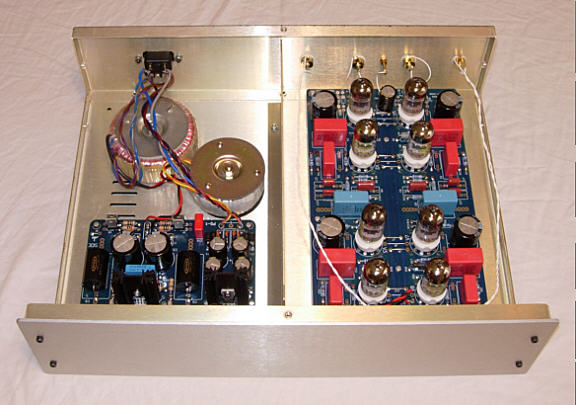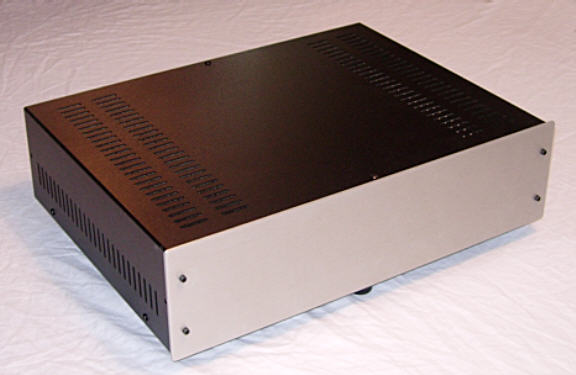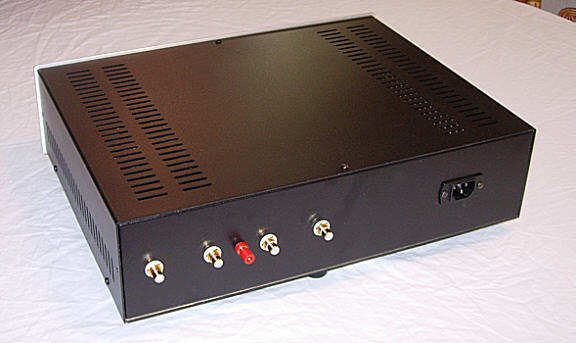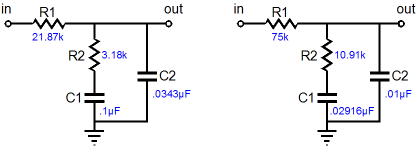| John Broskie's Guide to Tube Circuit Analysis & Design |
13 July 2008 At long last: the Aikido Phono Preamp
Aikido Phono Preamp I used a blank chassis that I had sitting about. (Yes, I am looking into offering a pre-punched chassis just like it.) You will notice that I didn't add an on-off switch. Why not? I use a master power switcher that turns on the signal sources first, then the power amplifiers. Nonetheless, I will have to add a fuse and power switch soon. The toroid power transformers (240Vac and 12.6Vac) were used because I had them. the second, smaller circuit board holds a high-voltage, solid-state regulator of my design, along with all the power supply rectifiers and a low-voltage regulator. (Yes, I will be selling them soon.) This Aikido phono preamp uses passive equalization, rather than active, feedback-based equalization. By cutting the highs and boosting the bass, the phono stage’s inverse RIAA equalization of the LP’s RIAA equalization curve returns the signal to flat. The passive equalization network sits in between two Aikido gain stages.
Two variations on the same equalization network are shown above. The advantage the lower-resistance version on the left enjoys over the higher-resistance version on the right is that the lower resistor values will add less noise to the signal and they are less perturbed by the second Aikido gain stage’s Miller-effect capacitance. The advantage the higher-resistance version holds over the low-resistance version is that the high resistor values will diminish the role the first Aikido gain stage’s output impedance; in addition, the equalization capacitors will be smaller (and cheaper). Since the Aikido amplifier stage uses a modified cathode follower as its output stage, the output impedance is fairly low. Nonetheless, this output resistance must be factored into the equations, as must the 1M grid resistor to ground at the input of second Aikido gain stage and the Miller-effect capacitance.
Tubes The output tubes (V2, V6, V4, V8) isolate the input tubes and deliver a low output impedance, yet they are not required to deliver high current into high-capacitance cables or headphones. Thus, a larger list of possible tubes is available: 6AQ8, 6BC8, 6BK7, 6BQ7, 6BS8, 6DJ8, 6FQ7, 6GC7, 6H30, 6KN8, 6N1P, 12AT7, 12AU7, 12AV7, 12AY7, 12AX7, 12BH7, 12BZ7, 12DJ8, 12FQ7, 5751, 5963, 5965, 6072, 6922, E188CC, ECC88, ECC99… The only stipulations are that the two triodes within the envelope be similar and that the tube conforms to the 9A or 9AJ base pin-out. A tube lineup of 12AX7 12AT7 passive equalization 12AX7 12AT7 or 12AX7 12AU7 passive equalization 12AX7 12AU7 works well and yields a final gain of about +46dB.
The PCBs Multiple Heater Arrangements: The PH-1 PCB allows either 6.3V or 12.6V or 25.2V heater power supplies to be used and 6V tubes, such as the 6N1P, can be used with 12V tubes, such as the 12AU7. See the User Guide for all the details on the heater arrangements. Power-Supply-Decoupling Capacitors: PH-1 PCB provides space for four sets of capacitors to decouple each Aikido gain stage from the B+ connection. This arrangement allows a large-valued electrolytic capacitor and small-valued film capacitor to be used in parallel, while a series voltage-dropping resistor completes the RC filter. Redundant Solder Pads: This board holds two sets of differently-spaced solder pads for each critical resistor, so that radial and axial resistors can easily be used (bulk-foil resistors and carbon-film resistors, for example). In addition, most capacitor locations find many redundant solder pads, so wildly differing-sized coupling capacitors can be placed neatly on the board, without excessively bending their leads. The boards and kits are available at the GlassWare Yahoo Store.
Next Time
//JRB
|
E-mail from GlassWare Customers And
High-quality, double-sided, extra thick, 2-oz traces, plated-through holes, dual sets of resistor pads and pads for two coupling capacitors. Stereo and mono, octal and 9-pin printed circuit boards available.
Designed by John Broskie & Made in USA Aikido PCBs for as little as $24 http://glass-ware.stores.yahoo.net/
The Tube CAD Journal's first companion program, TCJ Filter Design lets you design a filter or crossover (passive, OpAmp or tube) without having to check out thick textbooks from the library and without having to breakout the scientific calculator. This program's goal is to provide a quick and easy display not only of the frequency response, but also of the resistor and capacitor values for a passive and active filters and crossovers. TCJ Filter Design is easy to use, but not lightweight, holding over 60 different filter topologies and up to four filter alignments: While the program’s main concern is active filters, solid-state and tube, it also does passive filters. In fact, it can be used to calculate passive crossovers for use with speakers by entering 8 ohms as the terminating resistance. Click on the image below to see the full screen capture. Tube crossovers are a major part of this program; both buffered and un-buffered tube based filters along with mono-polar and bipolar power supply topologies are covered. Available on a CD-ROM and a downloadable version (4 Megabytes). Download or CD ROM
|
|||
| www.tubecad.com Copyright © 1999-2008 GlassWare All Rights Reserved |


















